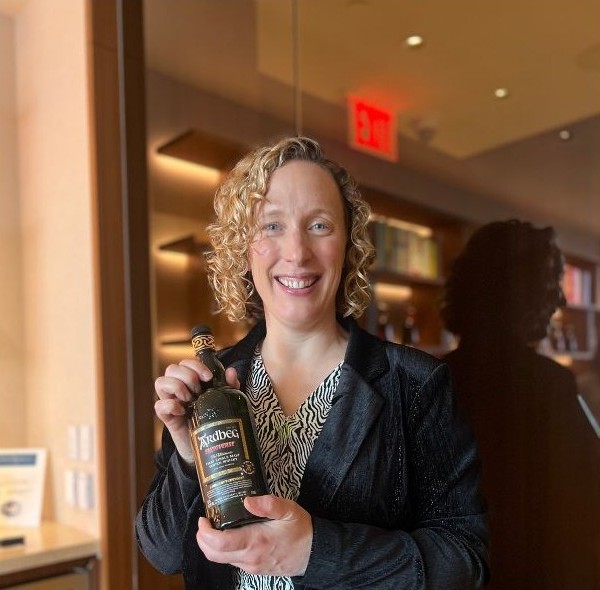How does one become the mind and hand that shapes not one but two of the most iconic brands in the world of Scotch? That was the first question in my mind when preparing to interview Gillian Macdonald, Master Blender of Glenmorangie and Ardbeg, two distinctively different whiskies, both in flavor as well as audience.
Gillian started her career in Welsh Distillery Penderyn in 2003 as the only female distiller in the UK and was lucky to work with late Dr. Jim Swan as Distillery Manager. In 2012, Gillian joined Dr. Bill Lumsden’s Glenmorangie and Ardbeg teams with oversight on both core as well as committee, releases for Ardbeg. I had the opportunity to meet Gillian during her tour in the US during Ardbeg Day (end of May 2025) to promote the launch of this year’s 25th Committee Release – Smokiverse. Recently Gillian was announced as Co-Chair of the Ardbeg Committee, replacing Jackie Thompson, together with Visitor Centre Planner Bryony McNiven.
How does one become the master blender behind two of the most iconic brands of premium whisky?
It was not really on my radar at all for a career. I did a chemistry degree back in the day, but I very much fell into the whisky industry, almost accidentally, after coming back from backpacking for a year and needing to find myself a job. So my entry into the world was probably not the most obvious way of going in. I know that now you can do your Masters in brewing and distilling and do various qualifications that would probably set you up in a very good trajectory as it were. But my learning was very much on the job, which I would highly recommend. If you’re wanting to get into a world of making whisky and eventually go on to doing the nosing, tasting, and the blending side, it is best to start off at a distillery so you can get some hands-on experience.
Learn the process, because every single aspect is super important. When adding and creating flavors in those parts of the process, you kind of need to know those bits. That way, you can understand when you get to the end of the process where you’re selecting your casks, whether they’re cask or front-end production-driven flavors. If you can, find a mentor or somebody who is already in that industry to get a bit of insight and go out and explore. Have a lot of fun exploring all the options in whisky that there are.
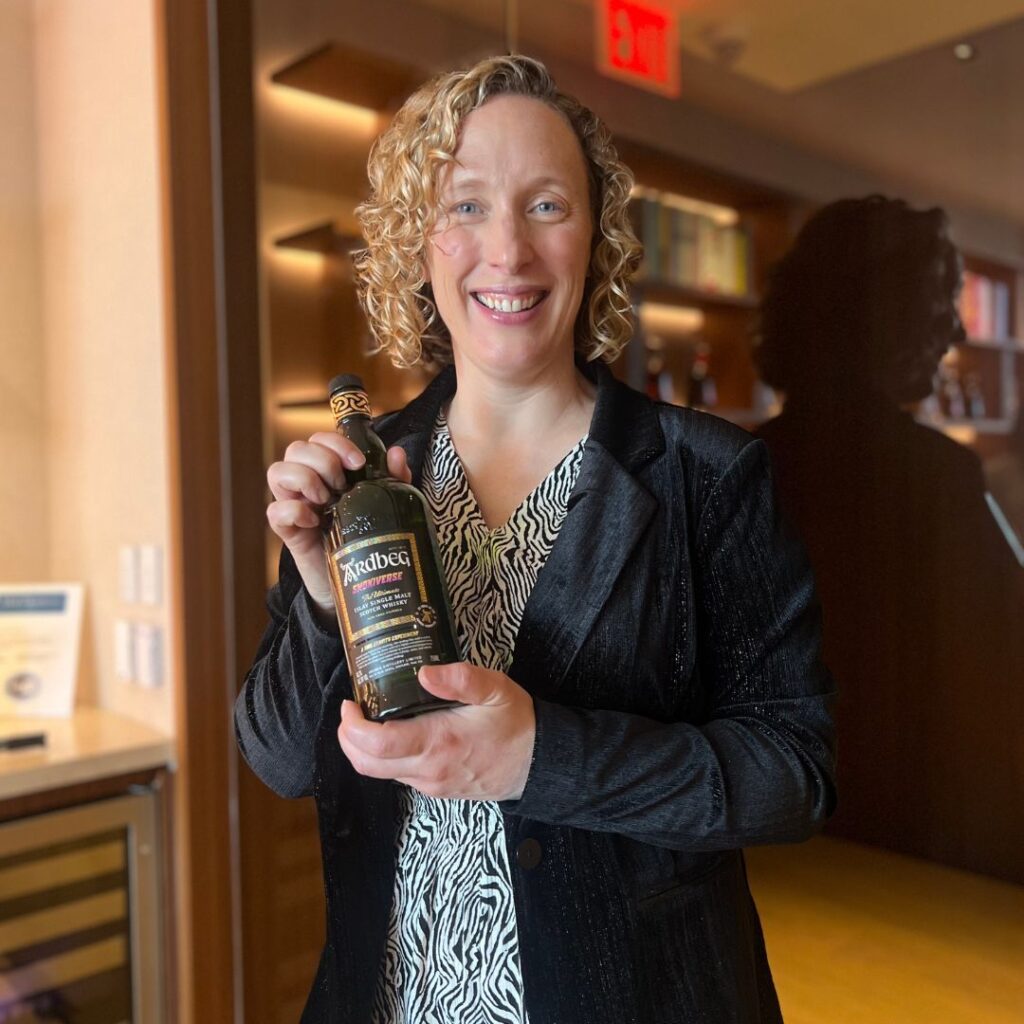
Congrats for the release of Smokiverse. Can you share some details about high gravity process?
For the Ardbeg Day releases, we generally try to put a whisky out into theworld that’s different from our core range. It’s still got to be recognizable as Ardbeg, still going to have that lovely peaty punch to it and the balance of flavors that you get with Ardbeg. What we did specifically, for Smokiverse, was changed just one of the processes and this was at the front end of the production and it revolved around the mash tun.
We laid this spirit down a good number of years ago and we’ve done a number of trials at Ardbeg that have resulted in special releases. This one was inspired mostly by a little bit of research that we’ve done on paper whereby we looked into what high gravity mashing did with regard to accentuating the flavors within the whisky. It basically means that you end up with slightly different fermentation conditions due to having a lot more sugar in your mash. As a result, the yeast then, when it starts to feed off that sugar during fermentation, produces a whole host of extra fruity, juicy ester-y flavors. That’s what was the inspiration behind it.
Also, it’s the proportion of grain to water: that’s exactly right. I’m sure that you’re familiar with the ingredients for making whisky: water, barley, and yeast. We started off with our lovely barley, which as always was peated to at least 55 parts-per-million for Ardbeg, that was then processed through the mill. That’s the point where the grain is opened up to allow us access to the starch within that grain. We then put it into the mash tun, which you can imagine is the large sort of saucepan-shaped cylindrical vessel at the distillery. This is the point where we decided to make the change… we added less water to the mash tun and as a result then we always super-concentrated up those sugars that we were extracting. As a result of that we had a much higher gravity mash. The gravity is almost the measure of the amount of sugar that you have in your wort, which is the sugary solution that goes then into the fermenting vessels. The higher the number on that, the higher the gravity mash.
Here for the yeast to feed off, the conditions of the fermentation were different, and it really did promote the formation of these really high fruity esters. That was really different from our standard production. When we distilled that spirit over, we saw a difference even, at that stage of the new make. We then chose to mature it in ex-bourbon casks and we chose to use quite a high proportion of second-fill bourbon casks as well. This was to allow the change that we’ve made at the beginning to shine through and not be dominated by the wood. It’s been sitting maturing and we’ve been tracking it all the way. We were thrilled to see that it was going to be coming out for this year’s Ardbeg Day.
We selected it because we thought it’s just that sweet spot, if we let it go on any longer the wood influence will start to dominate and kick.
Can you take us through the process of crafting Ardbeg committee bottles – from concept to cask to bottle?
I suppose a good example of one is the most recent one we’ve released, which is Ardbeg Eureka. That involved the committee quite heavily. Normally it’s mostly the whisky creation team that does the selection for the releases. On this occasion, though, on Ardbeg Day two years ago, we invited about 100 committee members to the distillery. We put them into this little scientific experiment where we gave them five cask-strength whiskies. We didn’t tell them anything about them at all. We got them to nose it, have a big discussion amongst themselves, and we gathered lots of information from them for tasting notes. They wrote down amazing an amount of rich, rich material, which we then went on to use. Finally, we also asked them to vote for their favorite one out of the five as well.
So, on that occasion, the committee kickstarted the process for us. It was the one that was voted the highest out of that little experience. We then took it back to the lab and worked on it further, to create our baby Eureka. The lab is lovely and is used in two parts and my role is split into two. One is the quality of the core range for both Glenmorangie and for Ardbeg. We’ll have samples sent in for bottling batches that have been put together. What we’re doing there is we’re assessing those against the benchmark samples and giving it the okay to be released for bottling. This involves lining up two samples, doing a compare and contrast, and two members of our team need to do that before it gets released from the distillery.
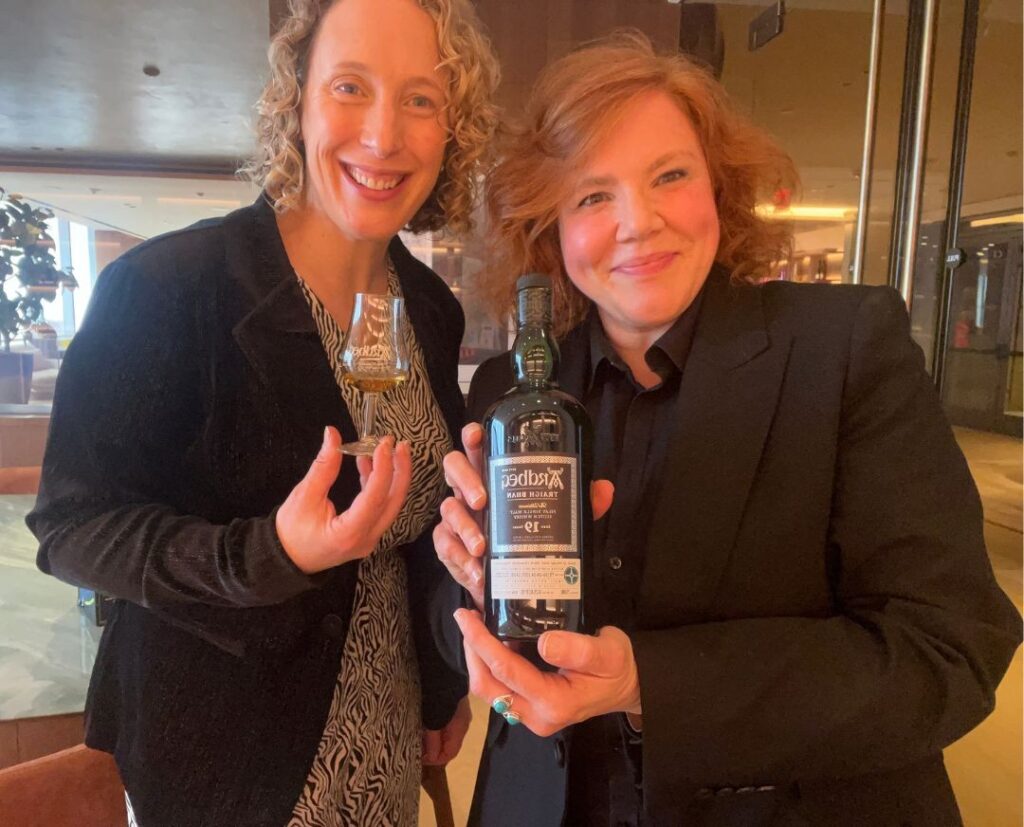
So what’s the life cycle of that?
With the things that we’re working on, the life cycle for whisky is long. With things like Smokiverse, that started 10-15 years ago, with the idea and then the actual distilling, and getting the process itself done at the distillery. Then, we’ve got to let it sit and mature by law, for at least three years in wood. It then comes down to flavor. So, the timeline to get Smokiverse has been in excess of 10 years. In the actual appointments, we’ve decided what is going to be released and we work alongside marketing for a year-and-a-half to two years in advance. We give them detailed tasting notes and we give them as much information as possible. Because for Ardbeg, it’s got a lot of humor in the brand, with a lot of quirkiness. Sometimes it’s little, maybe words that we’ve mentioned, which have been part of the production process that have then gone on to either be the names of the product or inspired the theme. So in this instance, it was the high gravity, the measurement of the gravity, and that then has spun off into space and, the Smokiverse. So we then sit down with (marketing) and they then go off and develop the story, packaging, and name and then make plans to work with the markets for launching, as well and put together all the educational packages and things.
So that’s the ultimate test… you’re looking for a balance of consistency and variety?
Consistency for core range and quality all the way. The variety part is the other half of it then, where we can introduce a few little quirky flavors or changes. Even within the variety. You have to keep the core in the heart of Ardbeg. It’s still got to be recognizable.
How do you keep it fresh? How do you innovate? Ardbeg has done the impossible of creating a niche audience, but also became most popular with the wider population, which is, to me, brilliant.
How do you maintain that balance of keeping both audiences happy, those that are looking for variety, those that are looking for tradition?
Well, I think it is a balance…I think the number one priority for our team is the core range. That is what we have put out there as the best representation of what Ardbeg can achieve. Certainly our Big 10 being the epitome of that. When you pick it up and nose Ardbeg 10, you’re literally transported to Islay, and Islay is actually in that glass and Ardbeg represents everything that it is. That’s hugely important to us. The limited editions that we do then, we do with purpose as our team is very familiar with how to make whisky from start to finish and all the various stages. We’re always looking for conditions within the Scotch whisky rules to see where we can make one change that will produce a different flavor – that’s a really fun part of the job and a little bit of a challenge. The consumer, I think, is always after something that is different as well. A lot of the time when we’re out and about…one of the first questions they asked us (is) : What’s new? We haven’t got a tap, which you just turn on these things. Some things take a lot of time. We can play around with different cask types, different combinations of cask types together and front-end production. But we really do try to do it with purpose, and also continue to keep the fun element, the humor element in Ardbeg as well. Because that’s important to us as a team. We have a great deal of fun when we’re working on Ardbeg. It’s a wonderful whisky to be part of – we want that to also then be conveyed out into how it’s received in the big wide world as well.
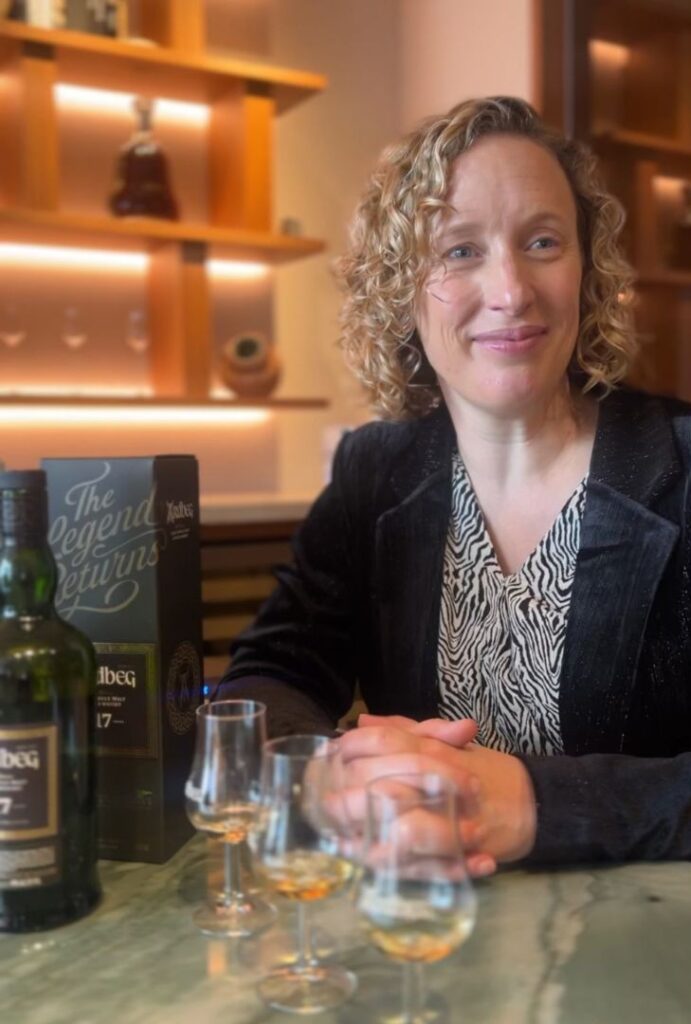
So what goes in your mind when you’re nosing a new make for either of the lines or the brands?
So, within our team, we nose and taste the new make spirit every week from the distilleries. Again, that’s just to check that all the parameters and flavors are exactly as they should be and the new make’s being produced within the specification that we’re after. When we’re nosing and tasting things at the other end of it, once it’s been matured, we’re looking to ensure that the quality of what we’re tasting and nosing is good enough to be put in a bottle and to have the name ‘Ardbeg’ on that label. So our team is very much focused around the quality elements of both the core range and to make sure that every time somebody picks up a bottle of Arbeg 10, it’s going to be exactly as they hoped it would be: rich in smoke, rich in all those citrus, lemon and lime flavors, all those herbal flavors, that sort of smoked fish, that smoked bacon – so that all those flavors are in there and it’s recognizable. Sometimes when you’re working on more experimental batches, it is just then trying to discover what’s in there, trying to recall, from your memory. Either it might evoke certain memories from childhood or, descriptors really. It’s trying to put into words what you’re nosing and tasting so that information can be conveyed over to whoever needs it, whether that be marketing, whether that be consumers. I mean, it’s an exceptionally fun process and I love the fact that it’s a bit of a mixture between art and science really.
So you’ve worked with two of the big largest masterminds in your time in Penderyn, Dr. Jim Swan. Also, with the fantastic Dr. Bill Lumsden. What are the key lessons that you gained from them?
I’ve gained a huge amount from both of my mentors, really.
In the early days, when I first walked into the world of whisky and knew absolutely nothing, I was methodically guided through every stage in a methodical and structured way. That taught me the skills I needed. Looking back, I didn’t really realize how much the sensory aspects of it come into play. When I worked under Jim’s wing for eight years at Penderyn, I shadowed everything he did. It was through him that I got interested in the maturation side of things and learned how to describe flavors. Most importantly, I was imprinted with the element of quality.
If you’re going to be putting your name to an edition or anything that’s going out the door, quality cannot be compromised at any point. It must have that to carry the ‘Ardbeg’ or ‘Glenmorangie’ names on it. Working with them instilled in me that quality is paramount. That’s the number one priority for our team, as custodians at the moment, to ensure that everything that leaves our facility is the best it can possibly be.
Finally, I would say that Bill has the ability to communicate very technical things in a fun and inviting way, especially the storytelling aspect of it. If you’ve ever done a tasting with Bill, he’s very good at engaging with people and bringing something to life as well. So, I think I’ve learned a fair amount on how to do that off him as well. And they’ve both been wonderful mentors for me.
So Islay Peat has been really developing. If you taste the peat from the 70’s, it’s not the same as the 90’s, and not the same as the 2000’s. So how do you see what’s the future of Islay Peat?
Well, it’s such a part of Ardbeg. Obviously, when they started drying their barley back in 1815, they just used the fuel that they heated their homes with and did everything else with. So it was, a choice made not through any crazy marketing scheme, but just a part of their way of life, as it were. It’s still very important to keep that. We have an environmental policy within the company and even within the Scotch whisky industry itself. So we’re part of the Scotch Whisky Association Peat group. It’s like a focus group which is all about the sustainability element of ensuring that we’ve had Ardbeg going for over 200 years. We want it to be here for the next 200 years. So we’re very invested in ensuring that that does happen. The amount of peat that the whisky industry uses compared to other industries is absolutely tiny. Less than one percent of what’s actually taken out of the ground is by the Scotch whisky industry. So you get a lot of flavor in there, but actually it’s coming from a relatively small source. We need to ensure that everything that we do going forward is sustainable and that’s a huge part of the Glenmorangie company sustainability ethos, as it were.
So what is your favorite Ardbeg that you have worked on and that you enjoy?
My favorite? Oh, that’s a tough question. That’s a good one. Well, I’d have to say Ardbeg 10 is probably my go-to favorite. It is literally, as I mentioned earlier on, Islay in a glass. It transports me back to standing on the pier and just being at the distillery. So to me it’s super special. I think there’s been some wonderful limited editions that we have done in the past. It’s been really good fun to see a lot of those come out as well. I really enjoyed the Smokiverse doing this, but I think Eureka was a really special one as well, because it was so interactive with the committee and it was really Dr. Bill.
I also really liked Fermentations as well, which was out a couple of years ago and that was all down to a broken down boiler back in 2007, which resulted in a three week long fermentation. They couldn’t get parts to the island and as a result, the fermentation was just left to run wild for three weeks. It was processed through the distillery and then a certain number of years later we tracked it through and it was really quirky. It’s like almost a sour mash. That was pretty special to work on as well, but then I just find all of them so wonderfully special. To be fair, I’m privileged. I really am very lucky to work on such an iconic whisky, for sure.
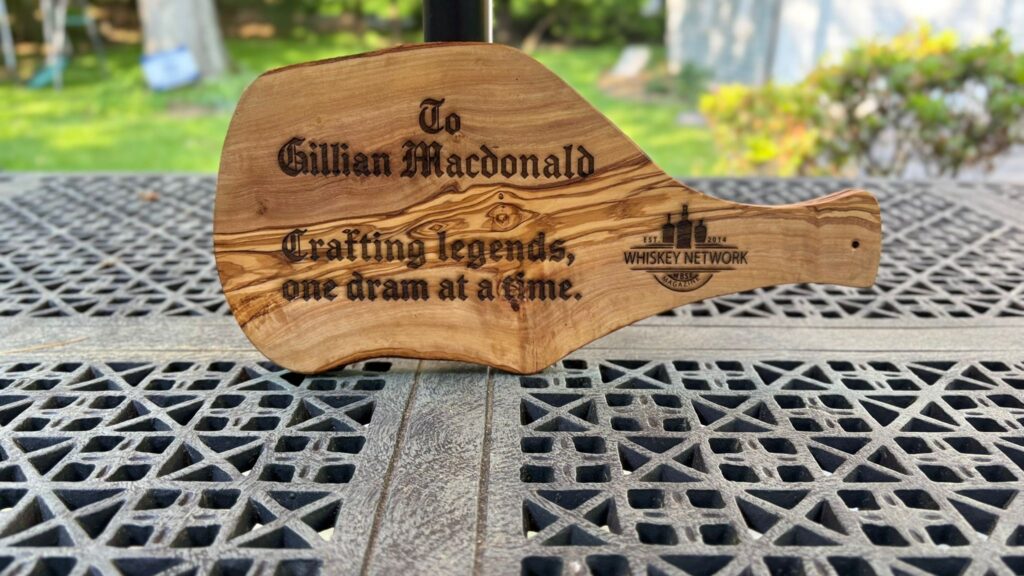
What goes through your mind during the first nosing of a potential Ardbeg or Glenmorangie release? Do you have a preference and how do you keep fresh with two distinctive brands and 180 different styles?
Well, one thing I’d say is don’t judge yourself by anything. You have a nose and you have a tongue and you’ll be doing absolutely fine. So it wouldn’t give you any pressure to be doing it in any specific manner. What I would suggest is if you’re ever nosing whiskies to keep your mouth open because that means that the flow through is an awful lot better and you’re probably going to pick up an awful lot more flavors when you first approach the glass, unless you know exactly what the strength is at. But it’s always worth to approach with caution, just to give your nose a little bit of time to adjust. Beyond that, then it’s just a matter of trying to pick up what exactly you can detect in there. Sometimes it’s worth adding a couple of drops of water to the whisky because it does change it. And again everybody works at their own preference when it comes to strength as well. I actually struggle at very, very high strengths. I actually bring it down to sometimes quite lower strengths as well.
When you breathe in afterwards, undeniably, you get those lovely layers of smoke and you even get that little bit of nice sort of savory saltiness in there as well, And then comes the smoke. It’s a relatively elegant whisky, this one, because of those dominant fruit flavors in there as well.
Whiskey Network Magazine would like to thank Gillian Macdonald for chatting with us. We appreciate her in-depth experience and hands-on knowledge. As new releases and important news becomes available, we will update our readers.

